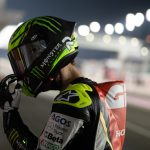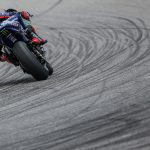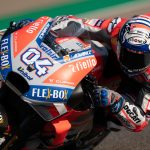Progress at Mattighofen has rarely been anything other than swift. It was, after all, how KTM’s team boss Mike Leitner convinced regular top-six finishers Pol Espargaro and Bradley Smith to sign for – and rapidly develop – the company’s nascent MotoGP project. “As a manufacturer, everything they’ve turned their hand to, they’ve been very successful,” Smith said last March, when his acquisition was announced. “From motocross to off-road, to enduro to Moto3. So you have to believe they will do the same in MotoGP.”
Some – your dear author included – may have thought Smith’s words were peppered with the usual fanciful optimism reserved for such occasions. There’s no point disguising it: this is a different kettle of fish to the other series he mentioned, a bird of another feather, MotoGP. As Kawasaki quickly found during its six-year stint in the top class, the requisite resources – not forgetting the money to fund them – to accumulate then sift through data and drive development forward make the eyes water.
Add in, the factory was forging ahead with its tubular steel chassis design, WP suspension– a break from the norm; each of the other five manufacturers use an aluminium frame and Ohlins forks – as well as needing to build up sufficient data to programme the RC16’s electronics package, and there were potential pit-falls aplenty.
But in Red Bull, KTM certainly has the monetary backing. The cost of its premier class project over five years is rumoured to be north of 200 million Euros. But one only needs to glance around the opulence at the sponsor-title home track to get an idea of how far Dietrich Mateschitz’s wallet extends. And in company CEO Stefan Pierer, the man who has made little secret of his animosity toward Honda, it has the ambition. Little wonder Smith was ready to sign once he was given a tour of the factory.
16 months on and it has become clear Smith’s thinking was well reasoned. In its first eleven races, KTM’s ever-improving RC16 has arguably displaced Suzuki’s GSX-RR as the fifth best factory machine on the grid. And now Aprilia’s RS-GP is in its sights. At Brno it finished a little over a tenth of a second behind Aleix Espargaro. Seven days on and, come the chequered flag, it was 6.9s ahead. Top tens in both flag-to-flag and dry race outings at the last two rounds too, the second seeing test rider and wildcard Mika Kallio come home 19s back of the winner – a rate of progress few could have foreseen.

The factory has certainly turned heads from the moment the RC16 unveiled. Be it the stockpiling of expertise from various teams, namely Repsol Honda, over the winter, the rapid turnover at parts, or the proximity of both riders to the front from the first race (bar, perhaps, Austin), the impression Pierer was deadly serious when announcing last August (at the Red Bull Ring) his dream to win the series outright has been difficult to escape.
Hearing of new chassis and shocks may not quite excite like, say, a hot lap, but it has been an exercise in itself, filling up notepads, attempting to keep up to date with this whirlwind rate of development, the like of which NASA would be proud. Chassis specs change by the week, and how about introducing an engine, featuring a rapidly different configuration, at the fourth round at Jerez? Espargaro called it “unbelievable”. Not quite, but rumour has it KTM had planned to introduce the ‘big-bang’ motor at Brno. That it arrived three months and six races before speaks volumes of the hours being put in at every level.
And don’t think this is some kind of exercise in vanity. Aside from the full-blooded willingness to push the bike closer to the leaders, consider how motivating it must be for Espargaro and Smith – both frustrated by a lack of development options when housed in Tech 3 Yamaha’s garage – to have a conveyer belt of new parts to sample. That spreads to the technicians too, with a degree of trust placed on them to work on parts that may not have come when working at other factories.
After the new engine’s introduction at Jerez, the summer test at Aragon was the next big step. “Sometimes you feel the changes but you don’t see it so much on lap time,” says Kallio. “But now the last modifications, we saw this on the lap time. A new frame, a new suspension – it was a step further. In Brno Pol and Bradley modified even more the frame, suspension and rear shock. Many, many other small things bring the bike to a better level.” That can be in no doubt. In Austria, Cal Crutchlow had the chance to scrap on track with Smith. “I couldn’t compete with him. He was pulling nearly half a tenth on two of the big straights.”
News that management is beginning to assert a degree of pressure on Smith in the German-speaking press, after a lacklustre showing on Sunday, could be viewed as unfair, given the Englishman opted for a development role while in his prime. After all, one of the project’s few failings to date has been the inability to cure the RC16’s turning issues. But, bearing the fact Smith was 16 seconds back of Kallio on Sunday, and at a loss to explain his lack of race-pace, KTM’s boss’ pointed words show a ruthlessness that underachievement won’t be tolerated.
At this rate, it’s tempting to wonder where the ceiling lies for this project. With a limitless wad of Euros available, one has to imagine a big-money offer will arrive at the garage door of one of the class’ leading names in the spring of next year (or earlier). Fitting Red Bull, an energy drink that claims to give you wings, should bankroll this operation. As, judging by its first six months in MotoGP, the sky’s the limit for KTM.
Photos by CormacGP/WD. JR Photo








